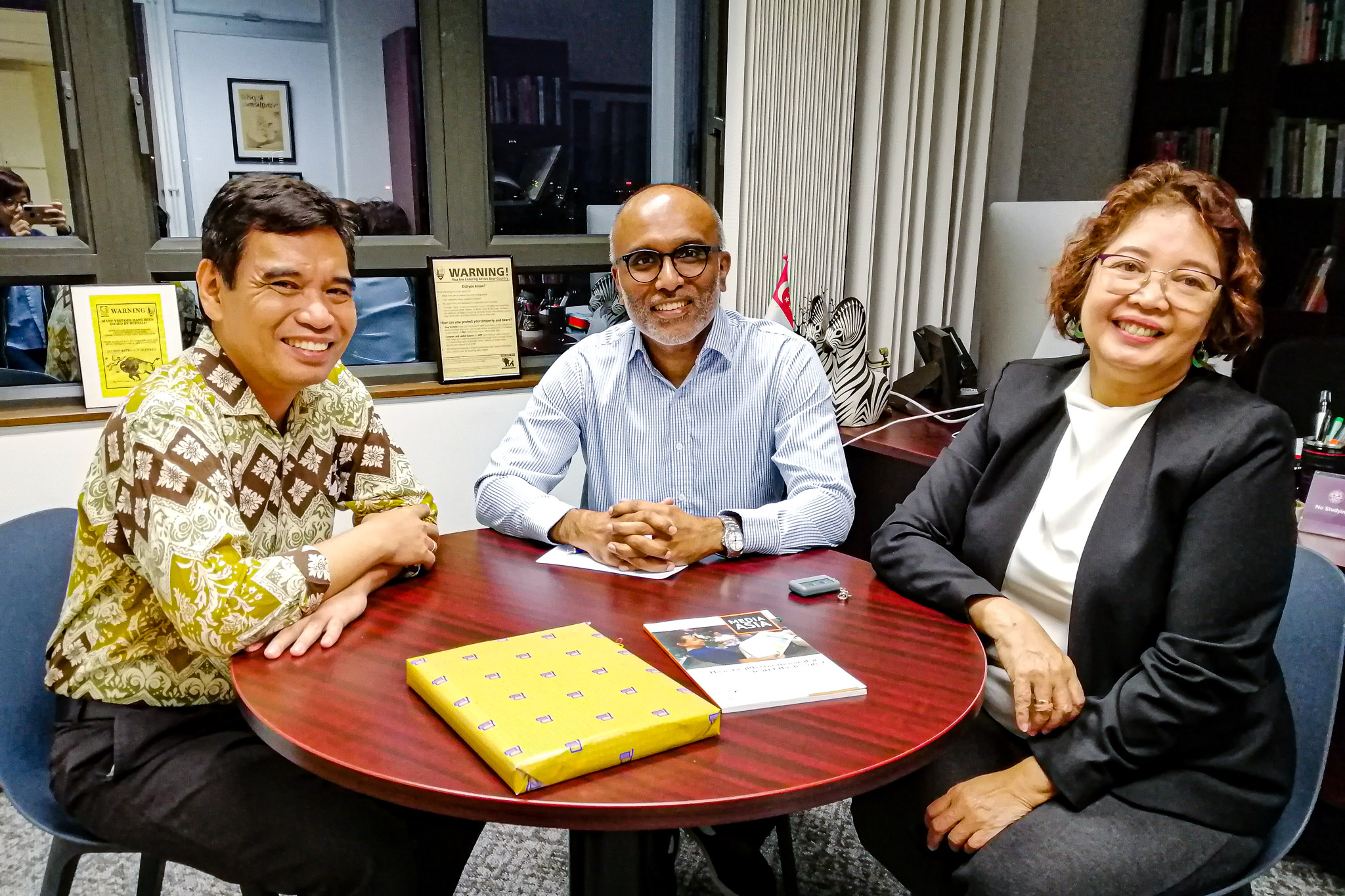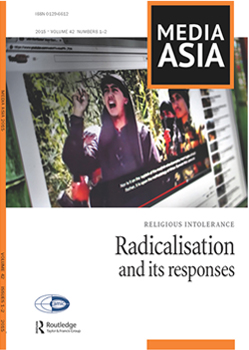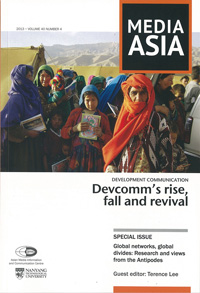
May 20, 2020 | Announcements, Call for Papers, Media Asia, News, Publications
Media Asia
published by AMIC and Routledge Taylor & Francis Group
Media and the Pandemic
SPECIAL CALL FOR PAPERS
Have you recently conducted research on media and the COVID-19 pandemic in Asia? If your findings are interesting, we’re interested!
Media Asia is a peer-reviewed quarterly journal published by the Asian Media and Information Communication Centre (AMIC) and Routledge Taylor & Francis Group. Published since 1974, Media Asia is now in its 46th year.
Manuscripts should focus on relevant issues related to media’s role in relation to the pandemic. These are some of the topics that may be interesting:
- Impact of COVID-19 on journalism, advertising, public relations, entertainment or any aspect of media (e.g., case studies, in-depth interviews with practitioners)
- Media coverage of the COVID-19 pandemic (e.g., content analysis, in-depth interviews with journalists)
- Government restrictions on media coverage during lockdown (e.g., effects of government’s “virtual pressers” with screened questions from journalists, weaponization of laws against the media, state of press freedom)
- Media technology and COVID-19 (e.g., how technology is being used to adapt to the changing environment)
- Media operations amid COVID-19 (e.g., reduction of media workforce, limited advertising, dependence on replayed and canned entertainment programs, impact on profit, changes in routines of media practitioners, adjustments in production processes)
- Media and the “new normal” (e.g., adjustments in the delivery of news and entertainment, quality of reportage due to limited movement of journalists and media workers)
- Media and history of global health crises (e.g., comparison of media’s role in past health crises like SARS to contextualize COVID-19 coverage)
These are just examples of research areas and topics. Please feel free to submit other manuscripts that focus on media’s role amid the COVID-19 pandemic.
In coordination with the editor, authors may also send commentaries on media and the COVID-19 pandemic, as well as reviews of books, films, plays and other media related to past health crises. These submissions are not subjected to peer review and have faster editorial decisions.
Given the journal’s adherence to the highest degree of academic scholarship, authors should be willing to submit their manuscripts to a double-blind review process. The journal editors shall initially review the manuscript. If it is assessed to be well-written and well-researched, the manuscript (with the author’s name and other related details redacted) shall be forwarded to at least two experts on the topic who will provide objective reviews. Similar to other peer-reviewed journals, Media Asia shall only publish manuscripts from authors who are able to revise their manuscripts based on the reviewers’ comments.
Based on data from the handling of 16 manuscripts submitted to Media Asia from 1 January to 12 May 2020, our journal has a relatively fast turnaround time in terms of editorial evaluation and reviewer invitation. Authors can be assured of a hastened process of feedback even if reviewers are usually given a maximum of 30 days to submit their comments.
Manuscripts should be written in English and should have not more than 10,000 words (including tables, references, captions and endnotes). They should also have an abstract of 100 to 150 words and keywords not exceeding five. Authors should use the American Psychological Association (APA) citation style. More information about submission format may be retrieved from https://authorservices.taylorandfrancis.com/tf_quick_guide/.
Interested authors may submit online at https://www.editorialmanager.com/rmea/default.aspx.
Effective 2020, Media Asia’s editor is Danilo Arao (University of the Philippines Diliman). The associate editors are Lisa Brooten (Southern Illinois University Carbondale), Pamela Custodio (University of the Philippines Los Baños), Roselyn Du (California State University Fullerton), Ma. Theresa Rivera (Far Eastern University Manila) and Zhang Yin Nick (Hong Kong Baptist University).
If there are any questions, please send an email to media.asia@amic.asia.
Feb 7, 2020 | Call for Papers, Media Asia, News, Publications
Media Asia
published by AMIC and Routledge Taylor & Francis Group
CALL FOR PAPERS
Do you want a broader, international audience to read your papers? Are your studies focused on analyzing current issues on media?
Faculty, students, media practitioners and researchers are invited to send their articles to Media Asia. It is a peer-reviewed quarterly journal published by the Asian Media and Information Communication Centre (AMIC) and Routledge Taylor & Francis Group. Published since 1974, Media Asia is in its 46th year.
Papers should focus on practices in journalism, advertising, public relations, entertainment and other aspects of media.
Given the journal’s adherence to the highest degree of academic scholarship, authors should be willing to submit their papers to a double-blind review process where the journal editors shall initially review the article and, if deemed scholarly enough, forward it (redacting the identity of the author or authors) to at least two experts (i.e., on the article’s chosen topic) who will provide objective reviews.
Articles should be written in English and should have not more than 10,000 words (including tables, references, captions and endnotes). They should also have an abstract of 100 to 150 words and keywords not exceeding five. Authors should use the American Psychological Association (APA) citation style. More information about submission format may be retrieved from https://authorservices.taylorandfrancis.com/tf_quick_guide/.
Interested authors may submit online at https://www.editorialmanager.com/rmea/default.aspx.
In coordination with the editor, authors may also send commentaries on burning issues of the day, as well as reviews of books, films, plays and other media. These submissions are not subjected to peer review.
Effective 2020, Media Asia’s editor is Danilo Arao (University of the Philippines Diliman). The associate editors are Lisa Brooten (Southern Illinois University Carbondale), Pamela Custodio (University of the Philippines Los Baños), Ma. Theresa Rivera (Far Eastern University Manila) and Zhang Yin Nick (Hong Kong Baptist University).
If there are any questions, please send an email to Arao at danilo.arao@up.edu.ph.

Nov 20, 2019 | Media Asia, Member Updates, News, Publications

ANNOUNCEMENT
November 15, 2019
Reorganizing Media Asia
The peer-reviewed journal Media Asia is transitioning to a new editorial leadership.
Danilo Arao, an associate professor of journalism at the University of the Philippines (UP) Diliman, is currently being phased in as the new editor. He replaces Cherian George, an associate dean of the School of Communication at Hong Kong Baptist University (HKBU).
Aside from teaching journalism at UP Diliman, he is also a special lecturer at the Department of Journalism of the Polytechnic University of the Philippines (PUP) Sta. Mesa, Manila. In the past, he taught courses in political science, journalism and communication at De La Salle University in the Philippines, Hannam University in South Korea and Technisché Universität (TU) Ilmeanau in Germany.
As a practicing journalist, he works as associate editor of the online publication Bulatlat Multimedia and writes a column for another online publication Pinoy Weekly. He is also board secretary of Kodao Productions (a multimedia group) and board treasurer of Alipato Media Center (publisher of Bulatlat Multimedia).
He has authored books in Filipino and English, examples of which are Kuro-kuro [Opinion] (Flipside Publishing, 2015); and The ASEAN guide: A journalist’s handbook to regional integration in Southeast Asia [with M. Löffelholz as co-author] (International Institute for Journalism-GIZ, 2011).
He brings to Media Asia his experience editing the peer-reviewed journals Plaridel, Philippine Journalism Review and Social Science Diliman, as well as reviewing manuscripts for other academic journals and publishing houses. Outside the academe, he worked for seven years as editor-in-chief and research head of IBON Foundation, an independent research think-tank that conducts research on socioeconomic issues.
Under Arao’s editorial leadership, Media Asia aims to publish articles on the practice of the media profession, focusing on trends and patterns that could help make sense of the current environment.
Media Asia thanks Cherian George for his services and welcomes Danilo Arao as its new editor.
Established in 1974, the peer-reviewed journal is published by the Asian Media Information and Communication (AMIC) Centre and Routledge Taylor & Francis Group.
(end)

Aug 27, 2016 | Asian Journal of Communication, Media Asia, Publications

Four 2016 issues of Asian Journal of Communication (AJC) and one Media Asia issue are already out.
AJC Vol. 26, No. 4 (August 2016) contains articles probing communication styles in different areas of the world, such as comparing the presidential rhetoric of South Korea President Lee and US President Barack Obama.
Theoretical articles are presented, such as probing moderating role of cultural orientation in explaining temporal orientation of self-referencing, and examining a new contextual perspective for crisis communication theory comparing the Eastern and Western traditions.
Communication issues that have arisen in specific countries are also probed, such as an examination of Chinese media’s implicit and explicit agendas; changes of cultural representation in Indonesia’s children’s television from 1980s-2000s; and examining the impact of message framing and temporal distance related to the communication to young Chinese of the human papilloma virus.
The AJC August 2016 issue also contains a book review of Making news in India: Star news and Star Ananda, written by SomnathBatabyal and published by Routledge.
Meanwhile, Media Asia Vol. 43, No. 1discusses the national anniversaries of Philippines and Indonesia as “narratives of remembrance”, with an interview of Dr. Crispin C. Maslog, AMIC Board of Directors chairperson, remembering the People Power Revolution. It contains two articles on what happened in Indonesia in 1965 when the Sukarno government was overthrown.
Articles also include a discussion of Japan press clubs, a Chinese dating show, television in India, reporting on the Malaysian Airline MH370 tragedy, border radio in Thailand and Malaysia, Indian Media Organization, and social media influencers in Singapore.

Nov 25, 2015 | Media Asia, Publications
 Media Asia 2015 Vol. 42, No. 1-2, has finally gone to press and will be out soon.
Media Asia 2015 Vol. 42, No. 1-2, has finally gone to press and will be out soon.
This first issue for 2015 is being published as a double issue.
This year, AMIC transferred the production of Media Asia to Taylor & Francis so as to benefit from its strong distribution capabilities. Taylor and Francis has to build its systems in handling the production of both the online and print journal which partly accounts for the slowing down of the production.
However, Media Asia editor in chief Prof. Cherian George is confident that AMIC members will see the benefits of the change starting in 2016.
In addition to several original research articles, Media Asia Vol. 42, No. 1-2 includes two interviews with scholars on the perennial problem of religious extremism and intolerance.
In this issue, Prof. Romila Thapar, one of India’s most eminent historians, discusses how right-wing harassment has narrowed the space for academic historians.
Meanwhile, Malaysian scholar Farish Noor talks about religious extremism in Southeast Asia, in the context of Islamic State’s internet savvy outreach in the region.

Aug 23, 2013 | Media Asia
|

|
Subscription
Individual: US$95 / SG$120.00
Subscribe
Institutional: US$200 / SG$250.00
Subscribe
|
Media Asia is a quarterly magazine which serves as an important platform for the exchange of views and information on mass communication in the countries of the Asia-Pacific region. Each issue of the journal has valuable information, views and comments relevant to communication professionals, scholars and laymen.
Editorial
Welcome to the new Media Asia. Since 1974, Media Asia has helped to fulfil AMIC’s mission of nurturing and promoting research and dialogue on media and communication in the region. Entering our fortieth year, Media Asia remains focussed on this role. But, starting with this issue, we will be approaching it in a whole new way.
The most obvious change is in our physical format. We’ve abandoned our old A4 size for this new compact package. Our new dimensions mirror AMIC’s other journal, the Asian Journal of Communication, to emphasise the complementary roles that we play.
It is between the covers that you’ll find the most significant changes. The core of this journal will remain: In each issue, we will still publish several original scholarly research articles blind-refereed by experts in the field. Media Asia’s Research section leans towards empirical studies with a fairly direct impact on practical challenges in Asian media and communication. In line with this continuity, Sundeep Muppidi remains in charge of our research section.
In addition, the new Media Asia contains substantial new sections highlighting current ideas, trends and concerns. Each issue starts with in-depth, journalistic reportage, a feature article analysing a major topic of contemporary interest. In our insights pages, authoritative thinkers and leading practitioners share their opinions on key issues. There is also a section highlighting noteworthy works. Here, we’ll review not only books but also relevant online reports, documentary films and other resources that merit your attention.
We are also excited about our new casefile section. Despite the huge growth of Asian media and communication activities and education, there is a crying need for well-written, easily accessible Asian case studies to use in teaching and research. Media Asia will do its part to help fill the gap.
All thesechanges are guided by our assessment of the strengths and limitations of conventional academic journals. Most journals are dedicated to showcasing the fruits of scholarly work, in the form of peer-reviewed research articles. But, this is only one part of the life cycle of scholarly inquiry. Before new findings are ready for harvesting, the soil has to be tilled and seeded with the right questions. And, after research is published, we need to take stock of how new knowledge is being used on the ground.
We’d like to think of the new Media Asia as contributing to this wider ecosystem. We aim to serve readers who want to harness reliable research and credible, critical insights in order to address contemporary media and communication challenges in Asia. We want to connect researchers, educators, students, practitioners and policymakers, by publishing not only the new findings contained in research articles, but also signposting new directions for research and flagging pertinent questions.
Of course, we will be only as good as the contributions we receive. Please consider Media Asia as an outlet for your research, following the submission guidelines on page 96. If you are interested in contributing to our other sections – Insights, Casefile and Noteworthy – please refer to www.mediaasia.info for more details.
Thank you.
Cherian George
Chief Editor, Media Asia







 Media Asia 2015 Vol. 42, No. 1-2, has finally gone to press and will be out soon.
Media Asia 2015 Vol. 42, No. 1-2, has finally gone to press and will be out soon. 
